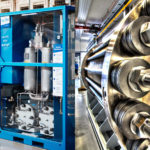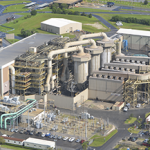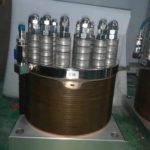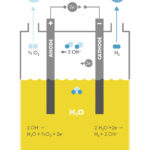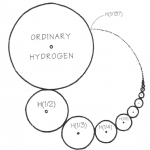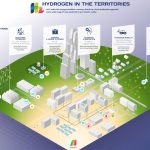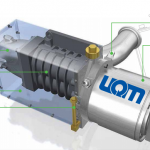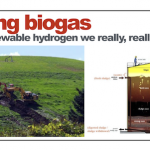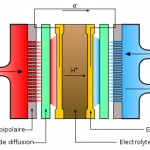Alkaline Electrolyzers – The Future needs a Metamorphosis
by Ishaan Goel
The second article in this series on water electrolyzers focused on polymer electrolyte membrane electrolyzers (PEMEs). PEMEs have increasingly captured the interest of industry over recent years, due to favorable technical characteristics. Despite this, the global electrolyzer market today is dominated by a much older model - alkaline electrolyzers (ALKEs). (For details of how both electrolyzers work, refer to the first article in the series).
The graph above shows the investment costs ($/kW) of ALKEs and PEMEs as the technology has advanced over time. In other words, they show the initial capital cost for every 1 kW of...
Earnings Roundup: Metals Prices Boost Covanta and Umicore
By Tom Konrad, Ph.D., CFA
You don’t have to own mining companies to benefit from rising metals prices.
This is a roundup of first quarter earnings notes shared with my Patreon supporters over the last week. Waste to energy operator Covanta and specialty metals recycler Umicore are both benefiting from skyrocketing metals prices.
Just as renewable energy and energy efficiency stocks have long shown that investors don’t have to own fossil fuel companies to benefit from rising prices of fossil fuels, recyclers like Covanta and Umicore are showing that you don’t have to own environmentally damaging mining companies to benefit from rising...
PEM Electrolyzers – Cracking the Chicken and Egg Problem
by Ishaan Goel
The first article in this series introduced two prominent types of water electrolyzers – alkaline electrolyzers (ALKEs) and polymer electrolyte membrane electrolyzers (PEMEs). Electrolyzers are devices that convert water into hydrogen and oxygen using electricity. They enable energy storage through hydrogen when combined with fuel cells, and can decarbonize hydrogen production for industry if supplied with renewable power. Subsequent articles shall focus on various characteristics of these two electrolyzer variants.
The graph above shows the investment costs ($/kW) of PEMEs and ALKEs as the technology has advanced over time. In other words, they show the initial capital cost...
Introduction to Electrolyzer Technologies
by Ishaan Goel
Hydrogen has become increasingly prominent as a potential carbon-free fuel, for both automobiles and providing electricity to buildings. It has direct applications in decarbonizing important industries like steel, and can serve as a storage medium for extra renewable energy over seasonal durations too.
Since hydrogen gas does not occur naturally in our atmosphere, its method of production is an essential component of the hydrogen economy. There are several such methods (discussed in detail here), but the one with least emissions involves using renewable power to run electrolyzers - devices that use electricity to convert water into hydrogen and...
The Many Shades of Hydrogen
by Ishaan Goel
INTRODUCTION
In 2020, hydrogen shot to the forefront of the renewable energy conversation, with stakeholders making major investments in its growth. The European Union has allocated nearly EUR 400 billion to hydrogen within its Covid-19 recovery package, to ramp up production capacity ~150 times by 2030. Globally, hydrogen production projects under development have nearly tripled (by capacity) with several firms announcing ambitious gigawatt-scaled ventures.
The appeal of hydrogen stems from its excellent capabilities as both an energy carrier and storage medium. Beyond its extensive usage in high-temperature industrial processes and manufacturing, it shows potential in areas that have proven...
PEM Fuel Cells – Hoping to Challenge Internal Combustion
The first article in this series introduced the two prominent types of hydrogen fuel cells - alkaline fuel cells (ALKFCs) and proton-exchange membrane fuel cells (PEMFCs). Fuel cells are devices that convert stored hydrogen into usable energy, and constitute an essential part of the hydrogen economy. Subsequent articles shall focus on various characteristics of these two cells.
The graph above shows the power costs ($/kW) of PEMFCs and ALKFCs as the technology has advanced over time. In other words, they show the initial capital cost for every 1 kW of fuel cell capacity (note that this axis is in the...
Brilliant Light Power – Commercialization Status
by Daryl Roberts
A potentially paradigm-shifting technology has been under development at an R&D firm in NJ called Brilliant Light Power. For people monitoring the situation, the question currently is about the status of commercialization. It is not a publicly held firm, but is in mid-stages of private equity capitalization in the range of $100-120M.
I recently read a book titled "Randall Mills and the Search for Hydrino Energy", offering a detailed and compelling history of the development of this novel renewable energy technology, authored by an insider, an intern who stayed on to work there for several years (published in...
McPhy: Growing With Hydrogen
by Debra Fiakas, CFA
Hydrogen system developer McPhy Energy SA (MCPHY: PA) recently reported impressive sales growth in the first half of 2019 - 23% higher than last year. Sales were boosted by delivery of a refueling station in Houdain, France for a bus operation that is 100% powered by hydrogen. New orders for projects in Germany, Bangladesh and Switzerland will keeps the company busy in the month ahead installing additional hydrogen fueling stations and electrolysis equipment for hydrogen production.
Despite the success, McPhy has not achieved profitability. Thus the company remains dependent upon financing to support operations. In 2017, the company secured an equity sales agreement with Kepler...
Beyond ZEVs: The Negative Emission Vehicle
by Jim Lane
Wandering the halls at the BIO World Congress and later to be seen again at ABLC NEXT this November, we ran across one of the most interesting technologies relating to ethanol production and markets we have seen in a month of Sundays, perhaps two months’ worth.
The problem
First, let’s revisit the problem. There’s simply too much ethanol being produced for the markets to absorb, given the Trump Administration’s massive cutbacks in US ethanol targets —In the resulting massively oversupplied market, the inevitable has happened, ethanol producers, growers and the Midwestern economies are being crushed. And they thought they...
Hydrogen in Oil’s Back Yard
by Debra Fiakas, CFA
As well derricks cast oily shadows across the landscape, Air Products and Chemicals, Inc. (APD: NYSE) has installed Saudi Arabia’s first hydrogen fueling station.The set up is tucked safely into APD’s new technology center in a science park, but the significance of this incursion into oil and gas country can be felt across the region.The fueling station, which incorporates APD’s SmartFuelhydrogen fueling technology, will service six Toyota Mirai fuel cell electric vehicles. Undertaken in cooperation with Saudi Aramco, the project is intended to demonstrate the potential for hydrogen as transportation fuel.
Hydrogen has potential advantages over conventional fuels, including Saudi Arabia’s oil and...
Shareholders Cry Foul as UQM Agrees to Buyout
UQM Technologies (UQM: NYSE) has agreed to be acquired by Danfoss Power Solutions for $1.71 per share in cash, providing a deal value near $100 million. UQM leadership expects timely review by government authorities and has recommended approval of the deal by shareholders. A date has not been set for the required shareholder vote. Assuming all goes according to schedule, a deal closing is possible sometime in the second quarter 2019.
Electric propulsion and generation technologies are at the core of UQM’s solutions for manufacturing, transportation and power industries. The substitution of electric motors for combustion engines has been driving demand for the UQM’s products. Market opportunities have abounded...
Hydrogenics: Will Hydrogen Skeptics Be Blown Away?
The hydrogen technology developer Hydrogenics Corporation (HYGS: Nasdaq) is taking on wind energy. The company’s fuel cell power systems for stand-by and site power sources, hydrogen generators for industrial situations, and energy storage and fuel solutions for fleet owners. Hydrogen has gained in popularity because it is a zero-emission fuel source when burned with oxygen. The energy efficiency of hydrogen as a transportation fuel is also enticing. An electric motor powered by hydrogen fuel cell is two to three times more efficient than an internal combustion engine running on gasoline.
Hydrogen is not without its critics. One of the criticisms is that hydrogen is not entirely a carbon-neutral...
There’s Hydrogen In That There Biogas
I don’t suppose that anyone actually dreams of hydrogen, but in the bio-economy there just isn’t quite enough of it and we read about it and sometimes think about it so much that we might as well be dreaming about it.
For those newer to the field, one of the problems of using biomass to make a fuel is that a carbohydrate contains around 53% oxygen by weight and needs about 16% more hydrogen that it contains to make a hydrocarbon fuel. That’s one of the reasons that biofuels are often esters (such as biodiesel) or alcohols (such as ethanol),...
List of Hydrogen Stocks
Hydrogen stocks are publicly traded companies whose business involves the use of hydrogen as energy storage or a transportation medium. See also fuel cell stocks.
This list was last updated on 8/27/2021.
AFC Energy (AFC.L)
Ballard Power Corporation (BLDP)
Bloom Energy Corporation (BE)
Cell Impact AB (CI-B.ST)
Defiance Next Gen H2 ETF (HDRO)
FuelCell Energy (FCEL)
Fusion Fuel Green PLC (HTOO)
Green Hydrogen Systems A/S (GREENH.CO)
Hazer Group Limited (HZR.AX)
HydrogenPro AS (HYPRO.OL)
HydroPhi Technologies Group, Inc. (HPTG)
HyperSolar, Inc (HYSR)
Hynion AS (HYN.OL)
ITM Power PLC (ITM.L, ITMPF)
MagneGas Corporation (MNGA)
McPhy Energy SA (MCPHY.PA)
myFC Holding AB (MYFC.ST)
Nel ASA (NEL.OL)
Nikola Corporation (NKLA)
PowerCell Sweden AB (PCELL.ST, PCELF)
Plug Power (PLUG)
PowerHouse Energy Group plc (PHE.L)
Proton Power Systems (PPS.L)
Quantum...
List of Fuel Cell Stocks
Fuel cell stocks are publicly traded companies whose business involves fuel cells, devices for efficiently converting the energy in a fuel (often hydrogen) directly into electricity by chemical means, without combustion. Applications include road transport, large-scale energy storage and short-haul transport such as forklifts.
This list was last updated on 5/6/2021
AFC Energy (AFC.L)
Ballard Power Corporation (BLDP)
Bloom Energy Corporation (BE)
Cell Impact AB (CI-B.ST)
Ceres Power Holdings PLC (CPWHF)
Enova Systems (ENVS) - out of business since 2015.
FuelCell Energy (FCEL)
Impact Coatings AB (IMPC.ST)
ITM Power (ITM.L, ITMPF)
McPhy Energy SA (MCPHY: PA)
myFC Holding AB (MYFC.ST)
Neah Power Systems (NPWZ)
Nikola Corporation (NKLA)
Plug Power (PLUG)
PowerCell Sweden AB (PCELL.ST, PCELF)
Proton...
Hydrogenics: New Capital, New Orders
by Debra Fiakas CFA Hydrogen technology developer and fuel cell producer Hydrogenics, Inc. (HYGS: Nasdaq) closed out last year ‘following on’ with new capital and new fuel cell orders. The company staged a public sale of its common stock through what is frequently referred to as a ‘follow on’ offering, coming along as this one did some years after the company’s initial public offering. The pricing of these new shares of common stock was ‘followed’ quite closely by announcement of a new order for Hydrogenics fuel cells by a forklift manufacturer in North America. The appearance...

